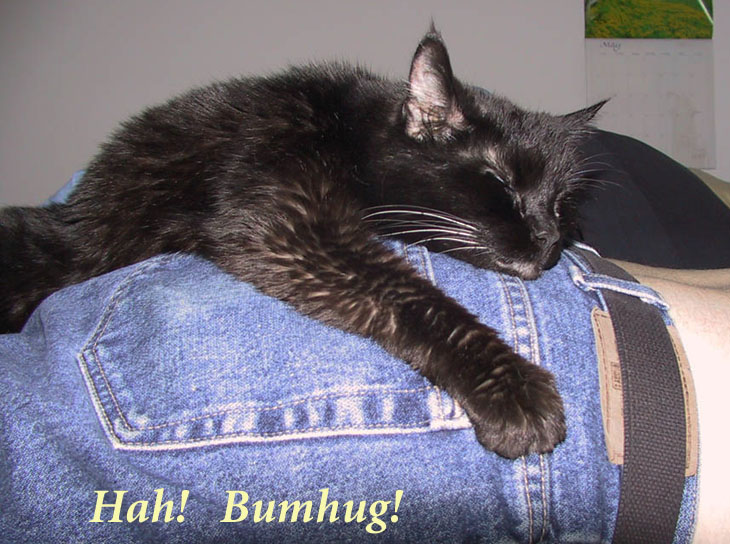
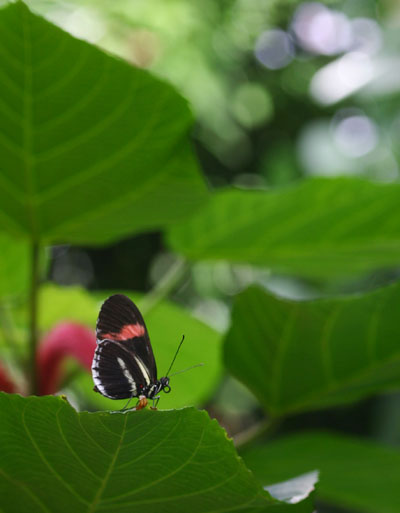 So, The Girlfriend’s Younger Sprog had a volunteer engagement at the North Carolina Museum of Life & Science in Durham, so I tagged along to kill time at the museum, because I hadn’t been in a while. As you may have already surmised if you’re exceptionally quick, the museum has a butterfly house.
So, The Girlfriend’s Younger Sprog had a volunteer engagement at the North Carolina Museum of Life & Science in Durham, so I tagged along to kill time at the museum, because I hadn’t been in a while. As you may have already surmised if you’re exceptionally quick, the museum has a butterfly house.
For a working nature photographer, such places can be nice, but not necessarily as useful as you might imagine. Everything is a captive subject, of course, but what reduces the value of the shots even more is that the lepidoptera species and the foliage are often from different locales and habitats, and thus may produce an ‘unnatural’ image. While I might like the way the image at left came together, any editor interested in either of the two species seen would probably not want the other to be included. This is a two-edged sword; it can cost a bundle to obtain images of such species in their natural habitat, but pricing the images accordingly will often exceed the budget of the potential client, so the goal is to produce as many useful images on any trip as possible, and try to recoup the costs in volume of sales. That is, unfortunately, not a business plan I’ve got in motion right now.
There’s still plenty that can be done, including detailed anatomical and artsy images, not to mention just having fun. I learned long ago that some butterflies are fond of sweat, so convincing them to remain on your hand can be as simple as swiping your forehead first. It would seem that this depends on the forehead; they definitely seemed to prefer my sweat over The Girlfriend’s, so it’s lucky that I’m a bountiful provider. I was tempted to let my ego run wild and imagine that her wiping my brow was something akin to the assistance provided a great surgeon while he worked, but my similarity to a dairy cow is probably more accurate. Her fingers, but my sweat, produced the image at top.

Now here’s the other side of captive photography. The chances of my obtaining an image like this in the wild are minute in the extreme, since this is mating behavior, and the dude on the left is indeed in midair. Regardless of the locale, the behavior displayed is typical and can easily be used as an illustration. The end use of the image is an important consideration; while it might be colorful and (seemingly) appropriate to capture a butterfly on a flower, such images are common. Behavior and life cycle images also have their markets, and far fewer people capturing them.
By the way, butterfly houses and rainforest displays usually mimic natural conditions, which means they are quite warm and extremely humid. Your camera will typically have to warm up a bit to eradicate the tendency to get condensation on the lens surfaces, and this will go faster if it’s out of the bag. Do not change lenses, or even operate the zoom functions, until the camera is warm – humidity inside the lens can take hours if not days to clear. Air circulation helps, but patience is the only real tool.
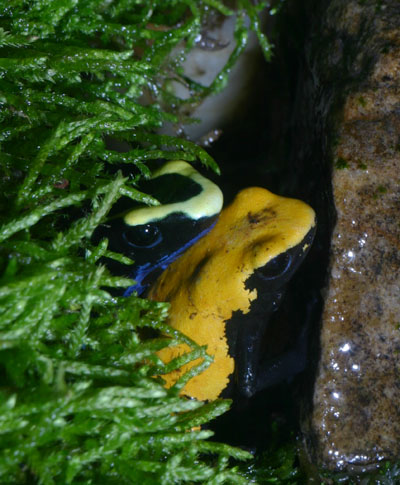 Adjacent to the butterfly house is a section of other critters in various small terrariums, and these present challenges of their own. Shooting through glass frequently presents difficulties, made worse if the glass isn’t perfectly clean – for some reason, the frogs seemed disinclined to wipe down their side. The best method for avoiding distortion is to shoot straight through the glass rather than at an angle, but this means your positions become quite limited. It also helps to reduce glare and stray reflections by being right against the glass, so if the terrarium is small this puts you very close to your subject – better have a lens that focuses quite close, or keep the extension tubes handy.
Adjacent to the butterfly house is a section of other critters in various small terrariums, and these present challenges of their own. Shooting through glass frequently presents difficulties, made worse if the glass isn’t perfectly clean – for some reason, the frogs seemed disinclined to wipe down their side. The best method for avoiding distortion is to shoot straight through the glass rather than at an angle, but this means your positions become quite limited. It also helps to reduce glare and stray reflections by being right against the glass, so if the terrarium is small this puts you very close to your subject – better have a lens that focuses quite close, or keep the extension tubes handy.
The real challenge, however, is lighting. The camera flash can produce glare from the glass that you’re attempting to shoot through, or from the glass on the far side of your subject. Direct light can throw contrasty reflections back from shiny surfaces, and the close conditions mentioned above can mean even getting light onto your subject (most especially without deep shadows underneath) is difficult. This is where an off-camera flash cord works best, and where The Girlfriend was a tremendous help. Poison dart frogs such as these can be very difficult to get any eye detail from, since dark eyes against dark skin usually means nothing but black, but the right light angle changes that. She was also able to aim the strobe past leaves that would throw shadows, and select a position that models the shape of the frogs better – it’s the gradients and shadows that provide three-dimensionality in photographs.
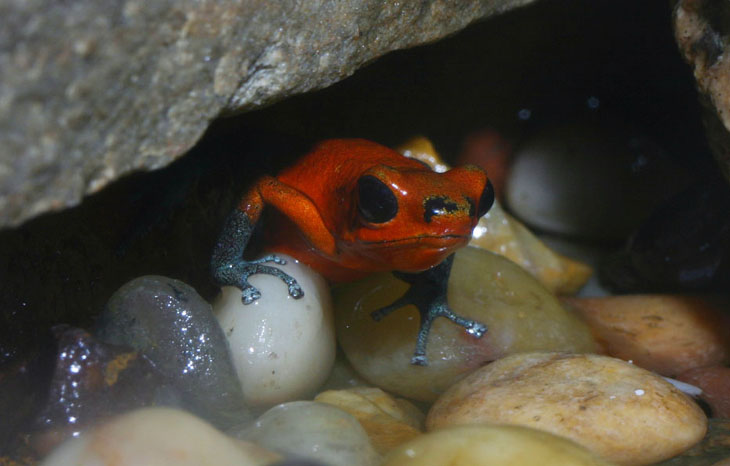
Case in point: this tiny, shy little specimen (charmingly, an Oophaga pumilio) who took shelter under a rock ledge and was barely visible in normal conditions. The body shape is defined by the shadows, and while the eyes might have benefited from a catchlight, a reflective sparkle, this matters less when surrounded by the red skin outlining the shape of the eyes – it might even have contributed to the menacing expression of discovering that the neighborhood dogs were at the garbage cans again (you have to admit, there is something purposeful about the frog’s position, and yes, I tried several variations in shooting angle before selecting this as the most expressive.) And while it’s easy to miss, you will note the blur at lower left from schmutz on the glass, since I was shooting at frog eye level and they never wash their hands adequately.
What we were most delighted with this trip, however, was the discovery that since our last visit, the museum had obtained some orchid mantises.

Maybe people who live in these areas are used to their local species, and are fascinated by the gray squirrels and crows we have in North America. Okay, probably not. But I’d truly love to spend a few weeks (preferably months) in some of these areas and wear the shutters out of my cameras. While closely related to the various mantises we have here, featured in my spring and summer posts, orchid mantises (Hymenopus coronatus) from Southeast Asia possess a flamboyant body shape that camouflages them among their favorite habitat, which also provides their name. I mean, c’mon, how can you not love something with eyes like that? But it was the restrictions of the housing display that prevented me from getting any images (yet) that showed them off better. First, it didn’t help that the two specimens were snubbing the orchids and branches within the terrarium in favor of climbing the glass and traipsing along the roof inverted (though I admit it was fun to see them climbing the glass, something I never thought a mantis could do.) However, this meant that I had to work very close to the insects to prevent reflections from the exterior, and framing choices are quite limited then. At any given time, I also had less than a minute where their perambulations were along a natural-looking surface, and they weren’t holding still then – mantids have a tendency to twitch and sway like leaves in the wind to fool their prey and disguise their advances, and this means staying on your toes to maintain tight focus.
And then there’s the background, which basically didn’t exist – the terrarium was hexagonal-shaped to permit good views, which isn’t as accommodating for nature photography. Yes, I admit to not coming prepared with a collection of leaves to hang against the far side for a nice backdrop – I’m trying to imagine how well that would have gone over with museum staff.
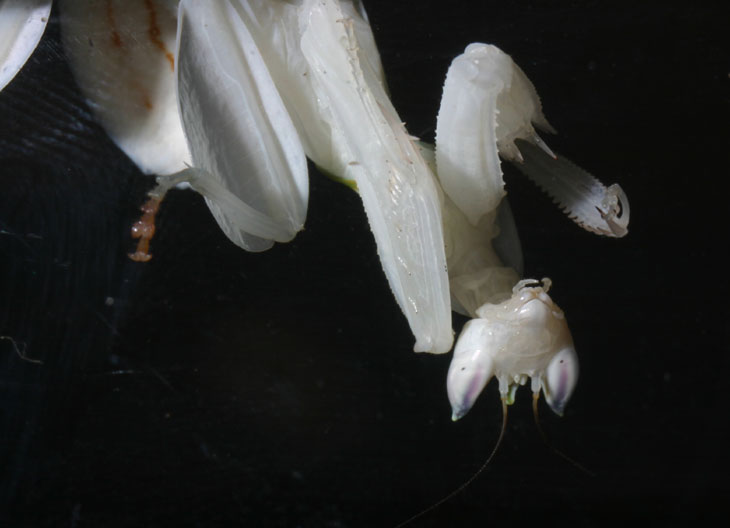
Seen here, the mantis has just finished cleaning a foreleg, having rudely refused to wait for my flash to recharge. Also note the one leg apparently hanging in space but actually clutching the glass, and the stray reflections that make endeavors of this kind so complicated.
Now, it’s not all bad, and I don’t want to discourage anyone from such pursuits, only to provide accurate expectations. The mantis will almost certainly provide a good pose on an orchid at some point, allowing both a natural-appearing setting and a great display of the camouflage, but it takes patience to wait for these opportunities. Add in courtesy to everyone else visiting the museum who would like to see the critters past you, and recognize that even in such ‘controlled’ conditions, obtaining a few good shots can be demanding and take a certain investment of time and effort. Considerably less so than flying to Malaysia, of course, but still more than simply walking up to the display and firing away.
There’s also such a thing as not stressing about the shot, and simply enjoying the museum for what it is – the Museum of Life & Science displays a tremendous amount of effort in education, activities, and variety, so it’s not just for photographers. I think I even saw some kids there (I often tunes such things out automatically – there might have been a lot for all I know.)
The leaf image from the previous post was obtained there as well, The Girlfriend’s assistance with the flash providing a stronger backlighting effect than the weak sunlight through the glass dome.






















































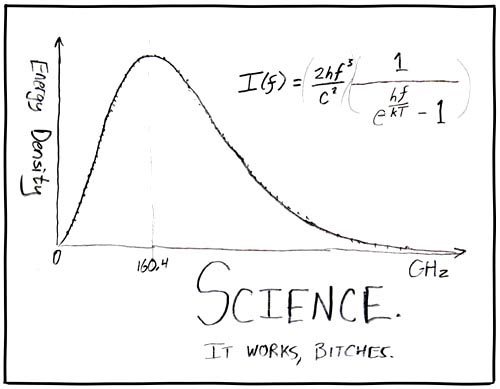

 We’ll take a quick look at closer range, too, mostly to show off the color of the eyes. It’s not that this is especially interesting, though I could call this a product of my Green Phase if I was inclined to be pretentious. But insect eye color, and some bird feathers, often depends on light angle rather than inherent pigmentation. I have often noticed that the throat color of ruby-throated hummingbirds (Archilochus colubris) doesn’t show up at all with direct flash, making it even more involved to try and get images that display this color. But I also have several arthropod images where the eyes take on a rainbow hue depending on the angle of the strobe. And so it was with this example, as I switched to augmented light for further images.
We’ll take a quick look at closer range, too, mostly to show off the color of the eyes. It’s not that this is especially interesting, though I could call this a product of my Green Phase if I was inclined to be pretentious. But insect eye color, and some bird feathers, often depends on light angle rather than inherent pigmentation. I have often noticed that the throat color of ruby-throated hummingbirds (Archilochus colubris) doesn’t show up at all with direct flash, making it even more involved to try and get images that display this color. But I also have several arthropod images where the eyes take on a rainbow hue depending on the angle of the strobe. And so it was with this example, as I switched to augmented light for further images.

 The net result of this is seen here, what I’m fairly certain is an Acanthocephala declivis, a variety of leaf-footed bug. The specimen is 30mm long, so not at all a small bug. The Girlfriend spotted it while out shopping one cold evening, sitting motionless on a sidewalk (the bug, not her.) Instead of stepping around (or on) it, she hunted about until she found a discarded drink cup, scooped it up, and brought it home for me to photograph. She had no knowledge of what it actually was, no idea of defensive mechanism or potential nastiness, but she knew I’d like it. Not to mention that it’s no longer the season for such subjects and my photography is slowing down commensurately, so I’m happy to have something to work with.
The net result of this is seen here, what I’m fairly certain is an Acanthocephala declivis, a variety of leaf-footed bug. The specimen is 30mm long, so not at all a small bug. The Girlfriend spotted it while out shopping one cold evening, sitting motionless on a sidewalk (the bug, not her.) Instead of stepping around (or on) it, she hunted about until she found a discarded drink cup, scooped it up, and brought it home for me to photograph. She had no knowledge of what it actually was, no idea of defensive mechanism or potential nastiness, but she knew I’d like it. Not to mention that it’s no longer the season for such subjects and my photography is slowing down commensurately, so I’m happy to have something to work with.